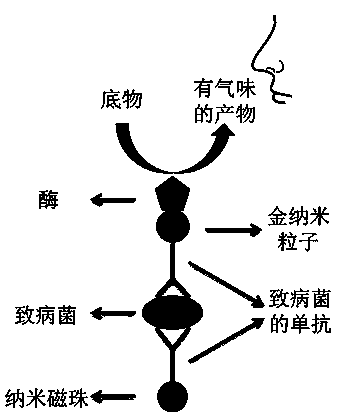Kit for detecting pathogenic bacteria and application of kit
A technology of pathogenic bacteria and kit, applied in the detection field of biological immune method
- Summary
- Abstract
- Description
- Claims
- Application Information
AI Technical Summary
Problems solved by technology
Method used
Image
Examples
Embodiment 1
[0034] Embodiment 1 detects the kit of Campylobacter jejuni
[0035] The kit for detecting Campylobacter jejuni includes the following reagents: gold nanoparticle solution, anti-Campylobacter jejuni antibody, apotryptophanase solution, nano-magnetic beads labeled with anti-Campylobacter jejuni antibody, bovine serum albumin solution and reactant solution . The reactant solution contains L-tryptophan and pyridoxal phosphate.
[0036] (1) Gold nanoparticles solution
[0037] The concentration of gold nanoparticles solution was 10 mM, and the average particle size of gold nanoparticles was 15 nm.
[0038] The preparation method of gold nanoparticles: add 5 mL, 1 g / L chloroauric acid solution in a conical flask, then dilute to 50 mL with sterilized water, heat to bumping under stirring, add 0.6~1 mL Sodium citrate solution with a concentration of 1% (mass percentage concentration), stirring continuously, until the color of the solution is stable to wine red.
[0039] (2) Anti-...
Embodiment 2
[0050] Embodiment 2 The present invention detects the application of Campylobacter jejuni kit
[0051] The specific steps of using the kit prepared in Example 1 to detect Campylobacter jejuni are as follows:
[0052] (1) Binding of apotryptophanase to anti-Campylobacter jejuni antibody
[0053] 1) Take 5 mL of gold nanoparticle solution, and use 0.2 mol / L K 2 CO3 Adjust the pH value of the solution to 8.0;
[0054] 2) Add 500 μL anti-Campylobacter jejuni monoclonal antibody and 500 μL apotryptophanase solution to the pH-adjusted gold nanoparticle solution, mix, shake and react at room temperature for 1 hour;
[0055] 3) Add 500 μL bovine serum albumin solution, mix, shake and react at room temperature for 30 minutes;
[0056] 4) Take out the reaction solution, centrifuge at 9.4 g for 7 minutes, take the precipitate and resuspend it in 500 μL PBST buffer to obtain the enzyme-antibody complex, store it at 4°C. After the enzyme-antibody complex is prepared, it must be used wi...
Embodiment 3
[0066] Embodiment 3 detects the kit of escherichia coli
[0067] The kit for detecting Escherichia coli is compared with the kit for detecting Campylobacter jejuni in Example 1, the only difference is that the anti-Escherichia coli monoclonal antibody is used instead of the anti-Campylobacter jejuni monoclonal antibody, and the nanomagnetic Beads replace nanomagnetic beads labeled with anti-C. jejuni monoclonal antibody.
[0068] (1) Anti-Escherichia coli monoclonal antibody
[0069] The concentration of anti-Escherichia coli monoclonal antibody is 0.1 mg / mL, purchased from Thermo Scientific Pierce, product number MA1-7029, the titer of anti-Escherichia coli monoclonal antibody is 1:20, and the affinity constant of anti-Escherichia coli monoclonal antibody is 2.8×10 8 L / M
[0070] (2) Nano-magnetic beads labeled with anti-Escherichia coli monoclonal antibody
[0071] The preparation method of nano-magnetic beads labeled with anti-Escherichia coli monoclonal antibody is as f...
PUM
 Login to View More
Login to View More Abstract
Description
Claims
Application Information
 Login to View More
Login to View More - R&D
- Intellectual Property
- Life Sciences
- Materials
- Tech Scout
- Unparalleled Data Quality
- Higher Quality Content
- 60% Fewer Hallucinations
Browse by: Latest US Patents, China's latest patents, Technical Efficacy Thesaurus, Application Domain, Technology Topic, Popular Technical Reports.
© 2025 PatSnap. All rights reserved.Legal|Privacy policy|Modern Slavery Act Transparency Statement|Sitemap|About US| Contact US: help@patsnap.com



